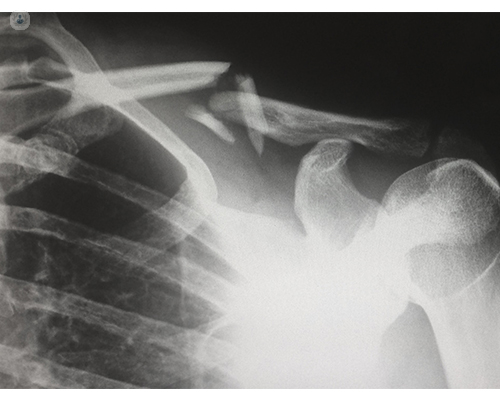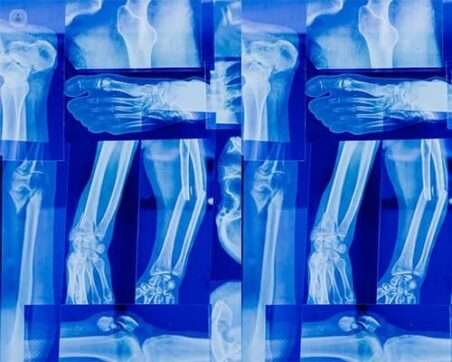Simplifying the complex: complex bone fractures explained
Written by: Professor Mohamed Imam
Bones make up the skeleton of the body. They provide us with the ability to lift our body up against gravity and move around, interacting with our environment. A crack or a break in a bone is a fracture. In this second article of a series on complex trauma, consultant orthopaedic surgeon Professor Mohamed Imam gives a detailed explanation of bone fractures and how they are involved in complex trauma.
What is a complex bone fracture?
The average person has two fractures during their lifetime. A bone fracture occurs when the bone is weaker than the physical force exerted on it. The fracture might be regarded as complex when it involves a joint or if it is shattered bone. Depending on the force of the break will usually determine the severity of the fracture. If the breaking point of the bone has only slightly been exceeded, it may crack as opposed to breaking all the way through. However, if the force is extreme, for example, the force from an automobile crash, then the bone may shatter.
If the bone fracture is broken in a way that bone fragments are sticking out through the skin or a wound is penetrating down into the broken bone, then the fracture is referred to as an open fracture. Open fractures can be devastating injuries that have the potential for infection, non-union, nerve or vessel injury, and long-term debilitating dysfunction of the limb.
What are the most common causes of bone fractures?
The most common causes of fractures are:
- Trauma – a fall, motor vehicle accident, abuse, or tackle during a football game can all result in fractures.
- Osteoporosis – this disorder weakens bones and makes them more likely to break.
- Overuse – repetitive motion can tire muscles and place more force on bone. This can result in stress fractures. Stress fractures of the hand, ankle, tibia, or hip are more common in athletes, for example, caused by running.
What are the different types of bone fracture?
Different types of fracture include:
- Closed (simple) fracture – the broken bone has not pierced the skin.
- Open (compound) fracture – the broken bone juts out through the skin, or a wound leads to the fracture site. Infection and external bleeding are more likely.
- Complicated fracture – structures surrounding the fracture are injured. There could be damage to veins, arteries, or nerves, as well as possible injury to the lining of the bone (periosteum).
- Comminuted fracture – the bone is shattered into small pieces. This type tends to heal slower.
- Avulsion fracture – muscles are anchored to the bone with tendons, a type of connective tissue. The tendon can be wrenched free and pull-out pieces of bone from a powerful muscle contraction. It is more common in knee and shoulder joints.
- Compression fracture – occurs when two bones are forced against each other. The vertebrae bones in the spine may have this kind of fracture. Older people, particularly those with osteoporosis, are at higher risk.
- Displaced Fracture – broken bone snaps so far out of place where two ends no longer line up straight. This fracture is more difficult to treat with immobilisation alone, and usually, surgery is required.
What are the most common bone fractures?
In the body, there are 206 bones, all with the potential to break in one way or another. It is no surprise that many people experience some type of bone fracture within their lifetime, as there is a vast array of accidents waiting to happen – for example, vehicle collisions, slips, falls, and other unfortunate incidents.
- Clavicle (collarbone)
The collarbone, otherwise known as the clavicle, is the most commonly broken bone, thanks in large part to where it’s positioned. Sporting events and car accidents are the most common causes of collarbone breaks. A sling to prevent the shoulder and the arm from moving is how these are mostly treated, but in some breaks, the pieces of bone move too far out of place and need to be realigned.

- Arms fractures
Arms are also broken frequently, being the second most broken bone among children. Breaks can happen in the upper or lower arm and are very susceptible to spiral fractures and compound fractures (multiple breaks in one bone). A specialist review is needed for the best treatment option as these injuries are always complex and can have adverse short- and long-term complications if not managed properly.
- Wrist Fracture
The wrist is most likely to be fractured when a person suffers a fall on the outstretched hand and takes all the body weight through the arm. Whilst there are several bones in the wrist, the most common wrist fracture is a distal radius fracture which involves a fracture of radius (one of the long bones of the forearm). Sometimes the scaphoid bone also gets broken without notice and typically requires surgery to heal. Other fractures can be treated with a cast, splint, or open reduction and internal fixation.
- Hip Fracture
Hip fractures are one of the most common and severe fractures in elderly clients. Normally, a fall on the side causes a break in the upper thigh bone, as well as osteoporosis causing bone weakening in the femur, typically one of the strongest bones.
- Ankle Fracture
Ankles are also prone to breakage. If the ankle is stable, the fracture may be managed by conservative methods such as a medical boot to a short leg cast. If there is a significant displacement or loss of ankle stability, either a closed or open reduction and fixation with pins and screws may be required.
- Vertebral Fracture
The 24 vertebrae in our neck and back protect our spinal cord. In people with osteoporosis, it is the most common break. Breaks are most commonly seen near the waistline and slightly above (mid-chest) or below (lower back).
If you or someone you know has recently had a complex bone fracture and it needs treatment, you can go to Professor Imam’s profile and book a consultation.

By Professor Mohamed Imam
Orthopaedic Surgery in London
Professor Mohamed Imam is an exceptionally skilled consultant orthopaedic surgeon who specialises in upper limb surgery, sports injuries, and complex trauma. Professor Imam uses the latest technology in diagnosing a wide


